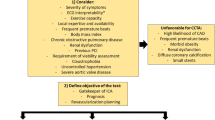Abstract
Purpose
In patients with stable coronary artery disease (CAD), two main options exist to guide management: initial invasive coronary angiography (CAG), or selective CAG after risk stratification using myocardial perfusion imaging (MPI). This study compared clinical outcomes between these two strategies in a large, real-world population.
Methods
The initial cohort comprised 1,000,000 randomly selected patients who had been entered in the National Health Insurance Research Database of Taiwan between 2000 and 2011. Patients with acute coronary syndromes, prior myocardial infarction (MI) or coronary revascularization, and prior treadmill testing or stress echocardiography were excluded. The remaining patients with suspected or known CAD were divided into those in whom initial CAG had been performed and those in whom initial MPI had been performed, and were followed until the end of 2011 for all-cause mortality, MI, and revascularization. A Cox proportional hazards model was used to estimate the risk of events after adjusting for covariates.
Results
The MPI and CAG groups each comprised 4,495 patients after frequency matching, with a similar Charlson comorbidity index (CCI). The MPI group had a significantly and dramatically lower incidence of revascularization (729 vs. 2,380, p < 0.001), MI (268 vs. 1,044, p < 0.001), and all-cause mortality (522 vs. 784, p < 0.001) than the CAG group. Multivariable analysis adjusting for age, gender, CCI, and comorbidities showed that in the MPI group fewer patients had revascularization (HR 0.24, 95% CI 0.22–0.26) and MI (HR 0.23, 95% CI 0.20–0.26), and the rate of all-cause mortality was lower (HR 0.58, 95% CI 0.52–0.64).
Conclusions
In patients with suspected stable CAD, compared with initial invasive CAG, a selective strategy guided by MPI was associated with lower rates of revascularization and MI and improved survival.


Similar content being viewed by others
Abbreviations
- CAD:
-
Coronary artery disease
- CAG:
-
Coronary angiography
- MPI:
-
Myocardial perfusion imaging
- MI:
-
Myocardial infarction
- CCI:
-
Charlson comorbidity index
- PCI:
-
Percutaneous coronary intervention
- CABG:
-
Coronary artery bypass grafting
- LHID2000:
-
Longitudinal Health Insurance Database 2000
References
Bangalore S, Maron DJ, Hochman JS. Evidence-based management of stable ischemic heart disease: challenges and confusion. JAMA. 2015;314:1917–8.
Cheng-Torres KA, Desai KP, Sidhu MS, Maron DJ, Boden WE. Conservative versus invasive stable ischemic heart disease management strategies: what do we plan to learn from the ISCHEMIA trial? Future Cardiol. 2016;12:35–44.
Hachamovitch R, Berman DS, Kiat H, et al. Exercise myocardial perfusion SPECT in patients without known coronary artery disease: incremental prognostic value and use in risk stratification. Circulation. 1996;93:905–14.
Iskander S, Iskandrian AE. Risk assessment using single-photon emission computed tomographic technetium-99m sestamibi imaging. J Am Coll Cardiol. 1998;32:57–62.
Hachamovitch R, Hayes SW, Friedman JD, Cohen I, Berman DS. Comparison of the short-term survival benefit associated with revascularization compared with medical therapy in patients with no prior coronary artery disease undergoing stress myocardial perfusion single photon emission computed tomography. Circulation. 2003;107:2900–7.
Vitola JV, Shaw LJ, Allam AH, et al. Assessing the need for nuclear cardiology and other advanced cardiac imaging modalities in the developing world. J Nucl Cardiol. 2009;16:956–61.
National Health Insurance Research Database, Taiwan. http://nhird.nhri.org.tw/en/. Accessed 8 November 2017.
Austin PC. Balance diagnostics for comparing the distribution of baseline covariates between treatment groups in propensity-score matched samples. Stat Med. 2009;28:3083–107.
Charlson ME, Pompei P, Ales KL, MacKenzie CR. A new method of classifying prognostic comorbidity in longitudinal studies: development and validation. J Chronic Dis. 1987;40:373–83.
Tonino PA, De Bruyne B, Pijls NH, et al. Fractional flow reserve versus angiography for guiding percutaneous coronary intervention. N Engl J Med. 2009;360:213–24.
Patel MR, Peterson ED, Dai D, et al. Low diagnostic yield of elective coronary angiography. N Engl J Med. 2010;362:886–95.
Lin GA, Dudley RA, Lucas FL, Malenka DJ, Vittinghoff E, Redberg RF. Frequency of stress testing to document ischemia prior to elective percutaneous coronary intervention. JAMA. 2008;300:1765–73.
Zheng X, Curtis JP, Hu S, et al. Coronary catheterization and percutaneous coronary intervention in China: 10-year results from the China PEACE-retrospective CathPCI study. JAMA Intern Med. 2016;176:512–21.
Anglemyer A, Horvath HT, Bero L. Healthcare outcomes assessed with observational study designs compared with those assessed in randomized trials. Cochrane Database Syst Rev. 2014;4:MR000034.
Hachamovitch R, Berman DS, Shaw LJ, et al. Incremental prognostic value of myocardial perfusion single photon emission computed tomography for the prediction of cardiac death: differential stratification for risk of cardiac death and myocardial infarction. Circulation. 1998;97:535–43.
Moroi M, Yamashina A, Tsukamoto K, et al. Coronary revascularization does not decrease cardiac events in patients with stable ischemic heart disease but might do in those who showed moderate to severe ischemia. Int J Cardiol. 2012;158:246–52.
Funding
This study was supported in part by the Taiwan Ministry of Health and Welfare Clinical Trial Center (MOHW106-TDU-B-212-113004), China Medical University Hospital, the Academia Sinica Taiwan Biobank Stroke Biosignature Project (BM10601010036), the Taiwan Clinical Trial Consortium for Stroke (MOST 106-2321-B-039-005), the Tseng-Lien Lin Foundation, Taichung, Taiwan, the Taiwan Brain Disease Foundation, Taipei, Taiwan, and Katsuzo and Kiyo AoshimaMemorial Funds, Japan. The funders had no role in study design, data collection and analysis, decision to publish, or preparation of the manuscript. No additional external funding was received for this study.
Author information
Authors and Affiliations
Contributions
Conception/Design: Guang-Uei Hung, Chia-Hung Kao. Provision of study materials: All authors. Collection and/or assembly of data: All authors. Data analysis and interpretation: All authors. Manuscript writing: All authors. Final approval of manuscript: All authors.
Corresponding authors
Ethics declarations
Conflict of interest
None.
Rights and permissions
About this article
Cite this article
Hung, GU., Ko, KY., Lin, CL. et al. Impact of initial myocardial perfusion imaging versus invasive coronary angiography on outcomes in coronary artery disease: a nationwide cohort study. Eur J Nucl Med Mol Imaging 45, 567–574 (2018). https://doi.org/10.1007/s00259-017-3872-4
Received:
Accepted:
Published:
Issue Date:
DOI: https://doi.org/10.1007/s00259-017-3872-4




